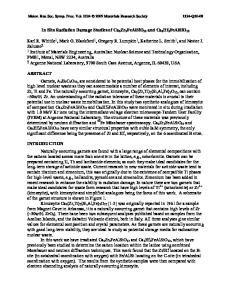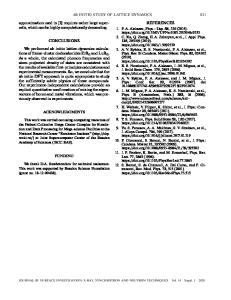Feasibility of Ca 12 O 12 Nanocluster in Lithium and Sodium Atom/Ion Batteries: DFT Study
- PDF / 5,342,620 Bytes
- 9 Pages / 595.276 x 790.866 pts Page_size
- 13 Downloads / 369 Views
Feasibility of Ca12O12 Nanocluster in Lithium and Sodium Atom/Ion Batteries: DFT Study Motahareh Noormohammadbeigi1 · HamidReza Shamlouei2 · Saeedeh Kamalinahad3 · Alireza Ghasemkhani1 Received: 10 July 2020 / Accepted: 14 October 2020 © Springer Science+Business Media, LLC, part of Springer Nature 2020
Abstract DFT calculations at the B3LYP-D3/6-31G (d) level of theory was employed to study the possibility of the Ca12O12 nanocluster in Li and Na atom/ion batteries. For this reason, the interaction of Ca12O12 nanocluster with Li/Na atoms and Li+/Na+ cations was calculated. Based on results the adsorption energies for two L i+/Na+ cations are considerably higher than their corresponding atomic species. Eg value of Ca12O12 nanocluster slightly increases in adsorption of Li/Na atomic forms while it was narrowed as consequence of the cationic forms adsorption. The values obtained for the cell voltage of Li/Ca 12O12 and Na/Ca12O12 were 1.82 and 2.49 V respectively which show that Ca12O12 may be appropriate for application in both lithium and sodium ion-batteries. Moreover, the cell voltage of Na@Ca12O12 is considerably high which shows that this nanocluster is highly beneficial for storage performance ion batteries. Keywords Ca12O12 nanocluster · Lithium · Sodium · Battery · DFT
1 Introduction Although Li-ion batteries have some disadvantages such as cost, lifetime, low-temperature performance and safety, they are very practical in many portable power and electronics devices and light vehicles [1–4]. Regardless of their eminent efficiency in comparison to different kinds of rechargeable batteries [5–8], wide availability, low cost, and nontoxicity of sodium make Na-ion batteries a good replacement for Li-ion batteries [9, 10]. Discovery of carbon nanotubes by Ijima [11], and their unique properties followed by an immense array of different applications which caused in the attraction of many scientists to study in the similar arena and nanomaterials to carbon nanotubes. One of the most interesting hetero-nanoclusters is (XY) n, which its most stable state is when n is equal to 12 [12]. This arrangement satisfies the tetragonal rule;
* Motahareh Noormohammadbeigi [email protected] 1
Department of Chemistry, Payame Noor University (PNU), Tehran, Iran
2
Chemistry Department, Faculty of Science, Lorestan University, Khorramabad, Lorestan, Iran
3
Independent Researcher, Arak, Iran
meantime no convincing explanation has been given about it. The (XY) 12 nanocluster includes eight hexagons and six square which is substantially subject to recent research [13, 14]. For example, the B12N12 nanocluster can be used as a sensor in sensing the CO, C O2, H2O and N H3 [15], H2S adsorption [16] cyanogen detecting [17], drug delivery [18, 19]. The X 12Y12 nanocluster were employed in many computational studies such as; studying the adsorption of sulfamide drugs by A l12N12, Al12P12, B12N12, and B 12P12 nanoclusters [20], protection of vitamin C by X 12Y12 nanoclusters [21], H2 adsorption
Data Loading...











